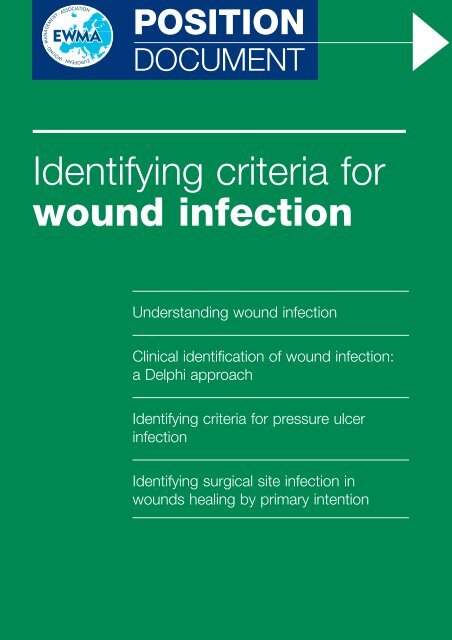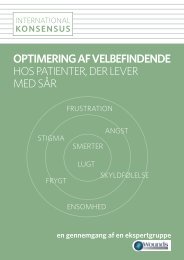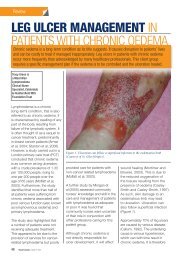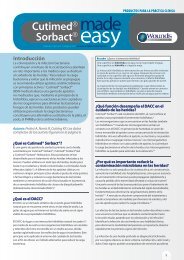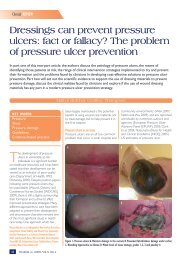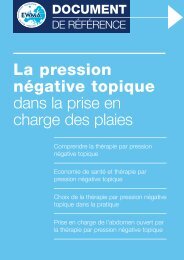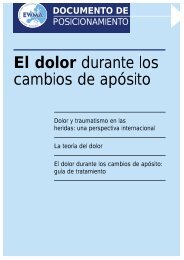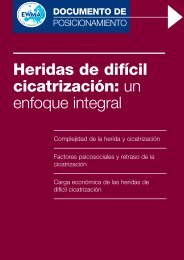Position Document: Identifying Criteria for Wound Infection - EWMA
Position Document: Identifying Criteria for Wound Infection - EWMA
Position Document: Identifying Criteria for Wound Infection - EWMA
- No tags were found...
You also want an ePaper? Increase the reach of your titles
YUMPU automatically turns print PDFs into web optimized ePapers that Google loves.
POSITIONDOCUMENT<strong>Identifying</strong> criteria <strong>for</strong> pressure ulcerinfectionH Sanada 1 , G Nakagami 2 , M Romanelli 3INTRODUCTIONCLASSIFICATIONRISK FACTORSHost issues<strong>Wound</strong> issuesThe early diagnosis of infection is difficult in pressure ulcers and requires a highlevel of clinical suspicion. When infection is present, the potential <strong>for</strong> furthercomplications such as osteomyelitis and bacteraemia is increased. This paperreviews the existing criteria and the criteria generated by a recent Delphi study 1 tooffer clarity in the clinical recognition of infection in Grade 3 or 4 pressure ulcers.Pressure ulcers are classified into four grades according to the guidelines of the EuropeanPressure Ulcer Advisory Panel 2 . <strong>Infection</strong> rarely occurs in Grade 1 or Grade 2 (partialthickness)pressure ulcers, but is more common in Grade 3 or 4 (full-thickness) pressureulcers 3 , which heal by granulation, epithelial cell migration from the wound edge andwound contraction induced by myofibroblast function 4 . The focus of this article is onrecognising criteria <strong>for</strong> the early diagnosis of infection in Grade 3 or 4 pressure ulcers.The majority of Grade 3 or 4 pressure ulcers occur in elderly people and as a result manyof these patients will have impaired immune systems related to advanced age,malnutrition or co-morbidities 5 . This increases their risk of infection and also of ‘silentinfection’. The latter occurs when several classic clinical markers often associated withinfection are absent 3 . This is because many patients with pressure ulcers are less able toactivate immune responses to the microbiological burden. It is also important torecognise that if there is a deterioration in the general condition of these patients, theirsusceptibility to infection increases.Grade 3 or 4 pressure ulcers are chronically open wounds, which may involve otherstructures such as muscle, bone or joints. This increases the potential <strong>for</strong> pathogenicinvasion. In addition, pressure ulcers are often in the pelvic region and are at increasedrisk of contamination from faeces or urine. Faecal materials contain high concentrationsof bacteria 6 , which can result in a heavy bacterial burden in the wound bed orsurrounding skin 7 . Urine is sterile and rarely contaminates wounds unless a urinary tractinfection is present. However, incontinence of urine can have an adverse effect on thesurrounding skin 8 .Many Grade 3 or 4 pressure ulcers contain necrotic tissue within the wound bed. It hasbeen shown that necrotic ulcers contain high levels of both aerobes and anaerobes, andthe density of all organisms is greater than in non-necrotic ulcers 9,10 .Tissue ischaemia is usually related to an inadequate blood flow and is closely linked topressure ulcer development. The relationship between transcutaneous oxygen pressure(TcPO 2 ) levels, which indirectly indicate the level of tissue oxygen density, and chronicwound infection has been demonstrated 11,12 . Compared with non-infected wounds,infected wounds show a significantly lower TcPO 2 .The skin of elderly pressure ulcer patients has a decreased density of Langerhans cells.This also results in decreased responsiveness and reduced ability to combat pathogeninvasion 13 .1. Professor, 2. GraduateStudent, Department ofGerontological Nursing, Divisionof Health Sciences and Nursing,Graduate School of Medicine,University of Tokyo, Japan.3. Consultant Dermatologist,Department of Dermatology,University of Pisa, Italy.KEY POINTS1. Host issues should be taken into account when assessing a patient’s susceptibility to infection.2. There is a need to develop a validated tool to facilitate recognition of infection in Grade 3 or 4 pressureulcers and to establish how such a tool can be used effectively in practice.3. The key to early identification of overt infection is recognising subtle changes in the patient and thechronically inflamed wound.4. The criteria generated recently by the Delphi expert panel offer detailed descriptive criteria <strong>for</strong> recognisinginfection in pressure ulcers. These could be used as a plat<strong>for</strong>m <strong>for</strong> further investigation.10
POSITIONDOCUMENT<strong>Identifying</strong> surgical site infection inwounds healing by primary intentionA Melling 1 , DA Hollander 2 , F Gottrup 3INTRODUCTIONIDENTIFYINGSURGICAL SITEINFECTIONDefinitions of SSI<strong>Wound</strong> scoringsystemsMost sutured surgical wounds heal normally. In these patients it is simple to identifythat no infection has occurred. However, <strong>for</strong> a significant number of patients woundhealing is affected by a variety of problems including haematoma, seroma (sterilecollection of serous fluid below the wound surface) and infection. The key toidentifying infection is recognising the difference between a complication of healing,such as a haematoma, and a surgical wound that has become infected. This paper usesexisting tools and the results of a recent Delphi study 1 to discuss the earlyidentification of surgical site infection (SSI) in wounds healing by primary intention.SSIs are largely preventable and are one of the most common healthcare associatedinfections (HAIs) to affect surgical patients. There are multiple factors that influencesurgical wound healing and determine the potential <strong>for</strong>, and the incidence of, infection 2,3 .The median time <strong>for</strong> a wound infection to present is nine days 4 . The increase in day-caseprocedures and shortened hospital stay has meant that many postoperative infections occurafter discharge. Patients there<strong>for</strong>e require careful follow-up in the community post surgeryto enable early identification of infection and appropriate instigation of treatment.There are many definitions of infection that can aid the process of accurate diagnosis. Onesimple definition is that infection presents as a purulent discharge or a painful erythema,indicative of cellulitis 5 . However, all simple definitions of infection contain an aspect ofsubjectivity; <strong>for</strong> instance, it may even be difficult to obtain agreement on the presence of pusin a wound between two healthcare workers, as pus can present in several different coloursand consistencies. This is why most definitions now try to aid the user with additionalcriteria and symptoms.The most widely recognised definition of SSI is that devised by Horan and colleaguesand adopted by the Centers <strong>for</strong> Disease Control and Prevention (CDC) 6 . This definition isnow used throughout the US and in Europe. It splits SSI into three groups: superficial,deep and organ space, depending on the site and the extent of the infection. A summary ofthe definition of superficial SSI is presented below. Controversially, the CDC definitionstates that a wound infection can be diagnosed by an attending physician or surgeonwithout apparently meeting the definition criteria 6 .Several wound scoring systems exist; two of the most widely recognised are ASEPSIS 7 andthe Southampton <strong>Wound</strong> Assessment Scale 8 . These enable surgical wound healing to begraded according to specific criteria, usually giving a numerical value, thereby providing amore objective assessment of the wound 7,8 . The ASEPSIS scoring system was devised toassess wounds following cardiothoracic surgery and can be used to categorise the severity ofinfection. <strong>Wound</strong>s are given a score depending on the extent of any wound healingCDC definition of superficial surgical site infection (SSSI) 61. Research Fellow – Nursing,Professorial Unit of Surgery,University Hospital of North Tees,Stockton-on-Tees, UK. 2. TraumaSurgeon, Department of TraumaSurgery, Bethanien Hospital,Frankfurt, Germany. 3. Professorof Surgery, University of SouthernDenmark, The University Centreof <strong>Wound</strong> Healing, Department ofPlastic Surgery, Odense Hospital,Denmark.• <strong>Infection</strong> occurs within 30 days of procedure• Involves only skin or subcutaneous tissue around the incisionAnd at least one of the following:• Purulent drainage from the superficial incision• Organisms isolated from an aseptically obtained culture of fluid or tissue from the superficial incision• At least one of the following signs or symptoms of infection: pain or tenderness, localised swelling,redness, or heat and superficial incision is deliberately opened by surgeon, unless culture of incision isnegative• Diagnosis of superficial incisional SSI by the surgeon or attending physicianThe following are not reported as superficial SSI: (1) stitch abscess (minimal inflammation and discharge confined to the points of suturepenetration), (2) infection of an episiotomy or neonate’s circumcision site, (3) infected burn wound and (4) incisional SSI that extends into thefacial and muscle layers (see deep SSI)14
IDENTIFYING CRITERIA FOR WOUND INFECTIONcomplications such as serous exudate, erythema, purulent discharge and separation of deeptissues. In addition, points are awarded <strong>for</strong> specific criteria such as positive swab results andprescription of antibiotics. Scoring is meant to take place in five of the first seven dayspostoperatively, and then the additional scores can be added over the subsequent six weeks 7 .The Southampton scoring system was designed <strong>for</strong> use in the postoperative assessmentof hernia wounds. It is much simpler than the ASEPSIS system with wounds beingcategorised depending on any complications and their extent 8 .These scoring systems require thorough patient follow-up, which is often timeconsumingand expensive. For this reason, they have not been widely implemented,although this situation may change with the trend towards mandatory postoperativesurveillance. Two studies have examined and used the ASEPSIS system and highlight itsbenefits in providing less subjective detailed in<strong>for</strong>mation on wound healing 9,10 . Anotherstudy has successfully used the Southampton system <strong>for</strong> routine infection surveillance andaudit 11 .VALIDITY OFEXISTING TOOLSDISCUSSIONClinical signs andsymptonsCriterionMean scoreCellulits 8 or 9Pus/abscessDelayed healing 6 or 7Erythema ± indurationHaemopurulent exudateMalodourSeropurulent exudate<strong>Wound</strong> breakdown/enlargementIncrease in local skin temperature 4 or 5OedemaSerous exudate with erythemaSwelling with increase in exudatevolumeUnexpected pain/tendernessFigure 1| <strong>Criteria</strong> identified bythe Delphi panel <strong>for</strong> acutewounds healing by primaryintention 1One recent paper has compared several definitions of infection in the same group ofpatients and found a large variation in reported rates (6.8–19.2%) 12 . For this reason, onedefinition should be used consistently when changes in the incidence of SSI are beingevaluated over time in a single institution. However, it is still premature to use woundinfection rates as a per<strong>for</strong>mance indicator <strong>for</strong> comparing different centres or countries, as aslight adaptation of the CDC definition was found to reduce the rate of infection by4.6% 12 . The same paper has also shown that the effectiveness of the ASEPSIS scoringsystem may be reduced when patients are discharged be<strong>for</strong>e the minimum seven days as thescoring system only identified 6.8% of patients with infection when 12.3% of patients wereclassified as infected due to the presence of pus alone 12 . The ASEPSIS and Southamptonscoring systems can help grade wound healing and identify infection; however bothsystems have been specifically designed <strong>for</strong> use after either cardiovascular surgery or herniasurgery. The recent publication by Wilson and colleagues 12 shows that ASEPSIS may be lessvalid when used on patients with a short length of postoperative stay and these concerns arereflected by other authors 9,10 .Even with experience and knowledge, early identification of infection in a surgical wound isdifficult as the wound itself may not be open to observation. Interpretations must be madeof what is observed in relation to what is happening under the skin. By the time a purulentdischarge is observed or cellulitis clearly apparent, infection is established. The presence ofaccompanying fever and leucocytosis as systemic indicators of infection varies 3 . <strong>Wound</strong>infection occurring below muscle or fascial layers or below thick, uninfected subcutaneoustissue (in obese patients) may have a delayed presentation or lack many of the local signsmentioned above.There is currently no validated, universal system that is designed specifically to aid in theearly identification of SSI and help instigate the correct treatment when infection occurs.However, a recent Delphi study 1 generated a list of criteria that were selected by the acutewounds panel as important indicators of SSI in wounds healing by primary intention (Fig1). The type of surgery was not specified and the assumption is that the criteria areapplicable to all types of surgical wounds. In examining the results of the Delphi study, thefollowing discussion raises some important issues related to the early recognition of SSI.Cellulitis‘Cellulitis’ and ‘pus/abscess’ were identified by the Delphi study as the most importantcriteria (ranked 8–9) in this wound type and may be considered as diagnostic of infection.Cellulitis is defined as a ‘spreading infection of the skin and subcutaneous tissues,characterised by local pain, tenderness, oedema and erythema’. This is a controversial15
POSITIONDOCUMENTindicator, as redness and swelling may often appear around the wound <strong>for</strong> other reasons,perhaps due to the normal inflammation of healing, removal of a dressing, allergy to adressing, tight-fitting clothes, seroma or haematoma. This ambiguity may be why it doesnot appear in the CDC definition.Mild erythema around thesuture sites and along the scar.There are no other signs ofinfection and this wound wenton to heal normally.More extensive erythema inconjunction with someswelling. The surrounding skinis hot and painful to touch. Thiswound eventually broke downwith a purulent discharge.ErythemaSevere erythema can be defined as a painful spreading redness around a wound 5 . Thedistinction between cellulitis and severe erythema is minor and most definitions of SSIrefer to ‘erythema’ rather than ‘cellulitis’ as an indicator of infection, providing it isaccompanied by other criteria such as a raised temperature or pain 5,7,8 .The inclusion of ‘erythema’ in a definition of infection has been shown to increase thereported incidence of SSI. In a study of prophylactic antibiotic use in hernia surgery, thereported incidence of infection was 9%. However, if infection had been defined purely asa ‘purulent discharge’ and/or ‘wound breakdown/abscess’, then infection rates would haveonly been 4% 13 . A review of the literature by Reilly 11 has shown that in many studies, ifthe definition is limited to a ‘purulent discharge’ alone then infection rates were found tobe between 1% and 5%. However, in those where ‘erythema’ or ‘cellulitis’ is included inthe definition infection rates were 6–17%.Purulent dischargeIt is universally agreed that the presence of pus and/or abscess or a purulent dischargeindicates the presence of infection 5-8 .It is interesting to note that the Delphi acute wounds panel 1 identified ‘seropurulentexudate’ and ‘haemopurulent exudate’ as important indicators of infection (mean score 6or 7). However, haemopurulent and seropurulent discharge could simply be classified as‘pus’ or a ‘purulent discharge’ and the inclusion of these as additional indicatorsrein<strong>for</strong>ces the need <strong>for</strong> clarity in relation to defining the terms used 8 . Discharge due toinfection most commonly presents around 5–10 days post surgery, although anydischarge from the closed surgical wound after 48 hours of closure is of concern andwarrants investigation.It is not clear how important ‘malodour’ is in the identification of SSI and it is notincluded in any of the validated definitions or wound scoring systems. However, adischarge that becomes foul smelling is a clearer indication of infection.Early signs of infectionCrucially, the Delphi study attempts to identify other, more subtle, early indicators ofinfection. These include ‘serous exudate with erythema’, ‘swelling with increase in exudatevolume’, ‘oedema’, ‘increase in local skin temperature’ and ‘unexpected pain/tenderness’.Most of these are also used by other definitions as collaborative signs of infection 5-7 .The focus needs to be on translating these criteria so they have clinical value to thenon-expert. For example, of more concern than ‘unexpected pain’, is pain that begins orincreases around the wound area in conjunction with other signs of inflammation severaldays after surgery. The inflamed skin around the wound will usually be warmer than thesurrounding area and also painful to touch. A summary of these issues is illustrated inFigure 2.Using criteria in combinationFrom the literature, it is clear that accurate diagnosis depends on looking at a number ofcriteria in combination to exclude causes other than infection <strong>for</strong> the clinical signs andsymptoms observed. A delay in healing, induration and/or wound breakdown standingalone may be related to other factors – <strong>for</strong> example, wound breakdown/enlargement may bedue to poor suturing, suturing under high tension or inadequate coagulation.16
IDENTIFYING CRITERIA FOR WOUND INFECTIONFigure 2 | Some basicrecommendations <strong>for</strong> the earlyrecognition of SSIGeneral issues:• It is important to recognise when the normalinflammatory process becomes abnormal andwhen this is due to infection• The level of suspicion should be raised if morethan one indicator of infection is present• The presence of pus in whatever <strong>for</strong>m is animmediate indicator of infection, although thismay be difficult to identify• When wounds simply fail to heal or where thereare disturbances to the normal healing process,further investigation is required• To define infection use validated tools (eg CDCdefinition)Practice points:• Any redness/inflammation around the woundlasting several days should be a cause <strong>for</strong>concern, particularly if the inflamed skin iswarmer than the surrounding area and painfulto touch• Pain that begins or increases around thewound area in conjunction with other signs ofinflammation/erythema several days aftersurgery is of concern• Any discharge from the wound 48 hours aftersurgery requires further investigation. Offensivesmelling discharge is a clearer indication ofinfection. Discharge due to infection ismost common around 5-10 days post surgery• Reasons other than infection <strong>for</strong> disturbancesin the normal healing process should beexcluded prior to a diagnosis of infection (egpoor suturing etc)• Consistent application of any scoring systemor tool is requiredCONCLUSIONIt is clear that there are already definitions and scoring systems that aid in the assessment ofsurgical wound healing and the diagnosis and classification of SSI. The most commonlyused, the CDC definition, uses stringent criteria to classify infection. This allows audit ofpractice and surveillance of SSI. However, these stringent criteria may place a reducedemphasis on the more subjective, subtle signs of infection such as erythema. The Delphistudy 1 has identified a number of these subtle indicators of infection that should not beignored clinically. Clarity and guidance is required <strong>for</strong> both the patient and clinician torecognise when the normal inflammatory process becomes abnormal and when the cause ofthis is likely to be due to infection. The focus needs to be on establishing whether infectionwill be potentially severe or devastating and will require treatment with antibiotics, orwhether the wound can be managed with less intervention and avoid unnecessary antibiotictreatment and risk of resistance.KEY POINTS1. There are well established definitions and scoring systems <strong>for</strong> defining, classifying and grading the severityof infection.2. The early recognition of SSI depends on identifying a number of criteria in combination.3. Discussions around the criteria developed by a recent Delphi study have been used to develop basicrecommendations in the early recognition of SSI.References1. Cutting KF, White RJ, Mahoney P, Harding KG. Clinical identification of woundinfection: a Delphi approach. In: <strong>EWMA</strong> <strong>Position</strong> <strong>Document</strong>. <strong>Identifying</strong> criteria <strong>for</strong>wound infection. London: MEP Ltd, 2005.2. Mangram AJ, Horan TC, Pearson ML, et al. Guideline <strong>for</strong> prevention of surgicalsite infection,1999. Hospital <strong>Infection</strong> Control Practices Advisory Committee.Infect Control Hosp Epidemiol 1999; 20(4): 250-78.3. Williams J, Taylor E (eds). <strong>Infection</strong> in Surgical Practice. London: Hodder &Stoughton, 2003.4. Leaper DJ, Peel ALG. Handbook of Postoperative Complications. Ox<strong>for</strong>d: Ox<strong>for</strong>dUniversity Press, 2003.5. Peel ALG, Taylor EW. Surgical <strong>Infection</strong> Group. Proposed definitions <strong>for</strong> the auditof postoperative infection, a discussion paper. Ann R Coll Surg Engl 1991; 73:385-88.6. Horan TC, Gaynes RP, Martone WJ, et al. CDC definitions of nosocomial surgicalsite infections, 1992. A modification of CDC definitions of surgical woundinfections. Infect Control Hosp Epidemiol 1992; 13: 606-08.7. Wilson AP, Treasure T, Sturridge MF, Gruneberg RN. A scoring method (ASEPSIS)<strong>for</strong> postoperative wound infections <strong>for</strong> use in clinical trials of antibiotic prophylaxis.Lancet 1986; 1: 311-13.8. Bailey IS, Karran SE, Toyn K, et al. Community surveillance of complications afterhernia repair. BMJ 1992; 304: 469-71.9. Hall JC, Hall JL. Evaluation of a wound scoring method <strong>for</strong> patients undergoingcardiac surgery. J Hosp Infect 1996; 33: 139-44.10. Byrne DJ, Lynch W, Napier A, et al. <strong>Wound</strong> infection rates: the importance ofdefinition and post-discharge wound surveillance. J Hosp Infect 1994; 26: 37-43.11. Reilly JS. The effect of surveillance on surgical wound infection rates. J TissueViability 1999; 9: 57-60.12. Wilson AP, Gibbons C, Reeves BC, et al. Surgical wound infection as aper<strong>for</strong>mance indicator: agreement of common definitions of wound infection in4773 patients. BMJ 2004; 329: 720-23.13. Taylor EW, Byrne DJ, Leaper DJ, et al. Antibiotic prophylaxis and open groinhernia repair. World J Surg 1997; 21: 811-15.17


